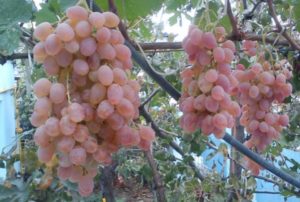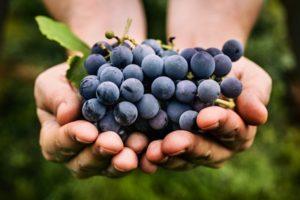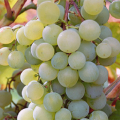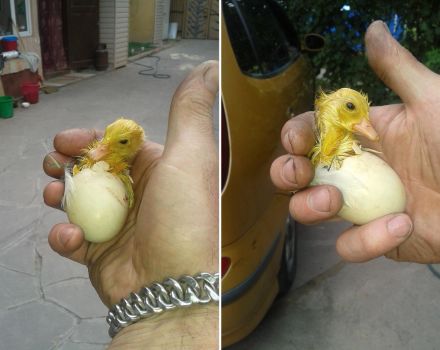Description and history of selection of Gourmet grapes, cultivation and care
Gourmet grapes with an unsurpassed aroma and nutmeg aftertaste easily take root in summer cottages and household plots in the southern and northern regions of Russia. That is why this pinkish-red grape, belonging to the table varieties of climbing shrubs of an early cultivar, has become so fond of many and has gained popularity among gardeners.
Content
- 1 Breeding history and region of growth
- 2 External indicators of the variety
- 3 Harvest quantity and taste of fruits
- 4 Planting and caring for young and adult seedlings
- 5 Harvesting period
- 6 Conditions and terms of storage of grapes
- 7 Reproduction methods
- 8 Diseases and pests - methods of dealing with them
- 9 Varieties of varieties and nuances when growing
Breeding history and region of growth
Thanks to the appropriate selection and crossing of two grape varieties - Kishmish and Talisman, the domestic breeder V.N. Krainov and managed to bring out a hybrid variety of fruit shrub called Gourmet.
The line of this hybrid form is designated by the following grape varieties - Early, Graceful, Rainbow, Gourmet, Lantern, with the distinctive features of each in the form of a certain ripening period and color... The berries of this varietal group are considered by many gardeners to be the most delicious and juicy.
External indicators of the variety
The description of this grape variety includes its external characteristics in the form of:
- resistance of the variety to frost up to -23;
- pronounced nutmeg berry taste;
- the shape of the bunch of grapes itself - cylindrical or conical;
- the mass of bunches, ranging from half a kilogram to one and a half;
- berries differing in an oblong shape;
- pinkish fruit color;
- the weight of each berry reaching 7-8 grams or more.
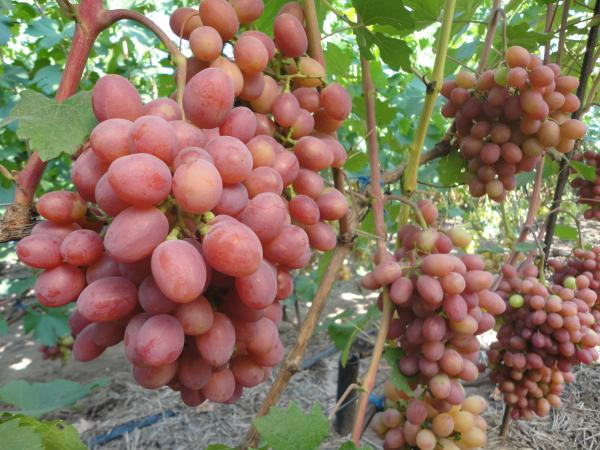
The vine of this hybrid ripens 2/3 of its length, and the flowers indicated by the female principle are easily pollinated. The gourmet is a tall and early ripening grape variety that ripens 110-125 days after bud formation.
Harvest quantity and taste of fruits
The berries of this variety are marked with dense and somewhat crispy pulp. The juicy and aromatic fruits of the Gourmet grape are covered with a thin, edible skin. Sweet and fleshy grapes, densely arranged in bunches, have no seeds.
The Gourmet variety begins to bloom in the southern regions in August, while in the northern regions, greenhouse cultivation or sheltering shrubs for the winter period is recommended.
The vines of this culture are literally strewn with grapes, so the described hybrid brings stable and rich yields to gardeners every year.

Planting and caring for young and adult seedlings
Having an idea about the specific features of growing this hybrid, you can achieve a good harvest from each bush in the vineyard.
Selection of seedlings
In the spring, they start harvesting the cuttings left after cutting the shrubs. The shoots of small thickness are divided into shoots about 30 centimeters long, with five buds on each. The tips of the seedlings are treated with paraffin, then a moistened cloth is applied over it and removed to a dark and cool place for about a month.
After a specified period of time, the primary material, almost ready for planting, is taken out, the tips are cut off from the cuttings and for three days they are placed in a honey mixture prepared on the basis of water and honey (2 liters of liquid / 2 tablespoons of nectar).
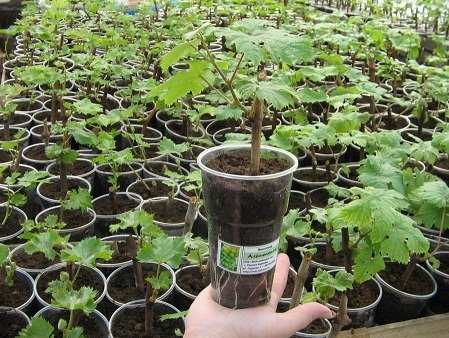
Timing
Young shoots are planted in a special container with garden soil. The planting material is placed in a sufficiently illuminated place at a temperature of about 18. After 30 days, with systematic watering, buds will appear on the cuttings, and then leaves will appear. In open areas, seedlings are planted at the end of spring, in already warm soil.
Demanding soil and planting pattern
An important criterion for the successful planting of a vineyard is the selection of fertile land somewhere in the hills and hills. Before planting, the land must be fed with complex fertilizer, preferably after the sun sets or in cloudy weather, in order to avoid burn injuries.
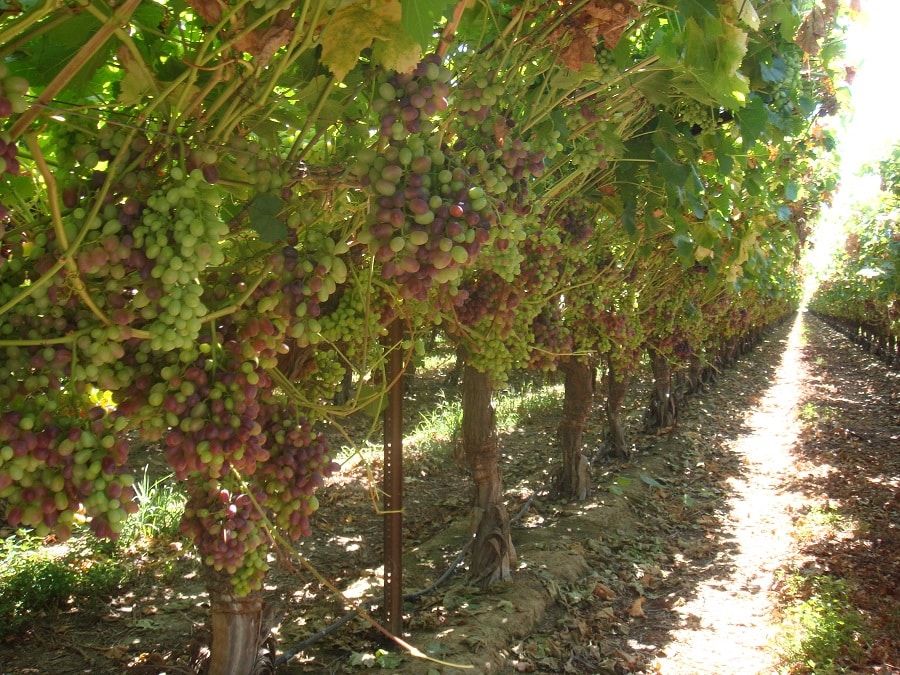
Cuttings prepared in the above way are planted in half-meter holes, keeping a distance of three meters. A support is installed in parallel to the base of the seedling, and the soil is mulched to generate additional heat. After that, the ground itself is covered on top with a film material for better heating of the soil.
Important! Young cuttings of this hybrid are not recommended to be planted in places where vineyards previously grew due to the mechanism of extracting nutrients and microelements from the soil inherent in these shrubs.
Lighting
Since grapes are a light-loving plant, planting them is not recommended in shaded areas, for example, where fruit trees grow. It is best to plant vineyards on the southern or eastern sides. Gourmet seedlings must be placed at a distance of 7 meters from any other crops, and at least 2 meters from all kinds of buildings.
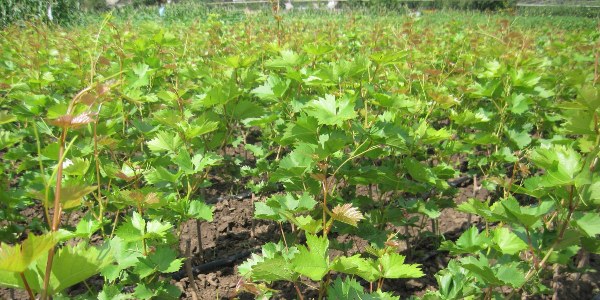
Watering mode
In the first 60 days, this hybrid variety is provided with constant watering, along with loosening the upper soil layer, for normal moisture absorption. In summer, in dry weather, the soil under the vineyard is mulched to preserve a certain microclimate. In the middle of the summer period, watering is stopped to saturate the fruits with sugars.
Fertilizer
After planting the cuttings, the soil is fertilized without fail. Until the moment of flowering, the shrub is fed with potash and phosphorus fertilizers. During the period of the ovary of the brushes, the branched shrub is fed with solutions based on manganese, zinc, and iron. In autumn, this variety also needs feeding using cow dung or chicken manure.
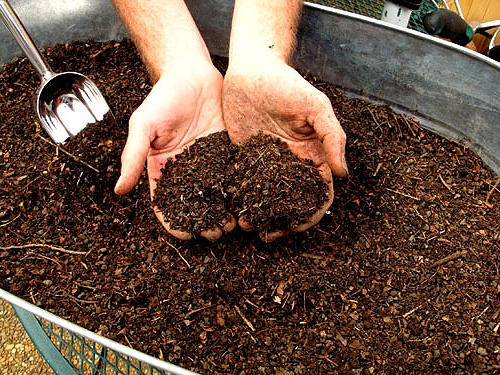
Treatment
In the spring, the vineyards are sprayed using Bordeaux liquid or a weak solution of copper sulfate.
Formation of a fruiting vine, pruning
Vineyards should be pruned in the first months of spring, until sap flow begins. The shrub is freed from the processes that have died during the winter season, leaving, ideally, only five buds.
Wintering
The gourmet is not a frost-resistant hybrid, although it can withstand frosts down to -23 Therefore, in the northern territories, this grape variety is best grown in greenhouses or covered with a covering material for the winter.

Pollination and the beginning of fruiting varieties
This variety is pollinated at the expense of nearby grape bushes with bisexual or male inflorescences. In the absence of such, it needs special additional pollination. The initial stage of fruiting of this hybrid is the last month of summer. And since the berries of the Gourmet variety tend to ripen exclusively on the bush, the harvest is carried out only when the fruits are already fully ripe.
Harvesting period
With a high yield, Gourmet varietal grapes are characterized by early ripening. In early August, amateur gardeners begin to delight the kilogram bunches of the already ripe berries of this grape variety.

The average yield of this variety from one hectare reaches 20 tons, and up to 8 kilograms of juicy berries can be harvested from each bush of a branchy shrub.
Conditions and terms of storage of grapes
Grape bunches perfectly tolerate transportation, storage at temperatures up to +5. In addition, the fruits of the described hybrid themselves do not burst during storage and are not exposed to any damage from insects.
Reproduction methods
This hybrid propagates by cuttings, with fairly good rooting of the planting material using the deep and horizontal method.
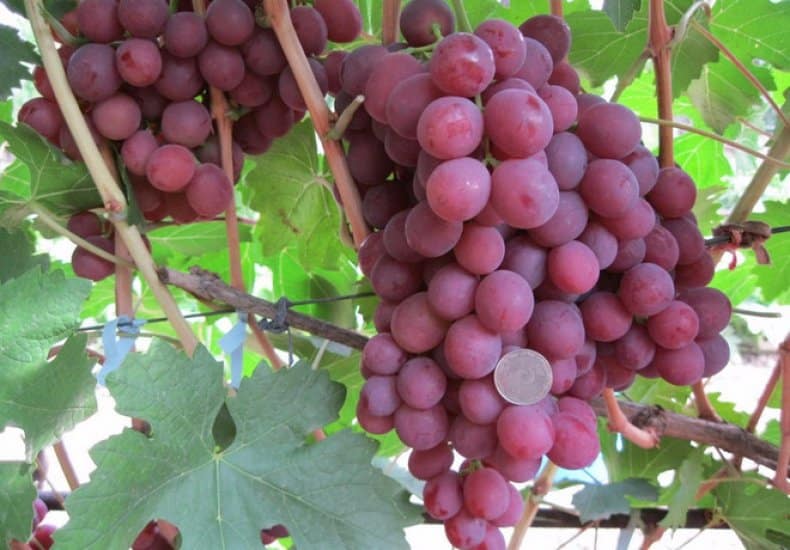
Diseases and pests - methods of dealing with them
This varietal hybrid is relatively resistant to mildew and gray mold. But young and weak shrubs often infect infections in the form of powdery mildew and powdery mildew. In this case, the leaves and grape fruits begin to become covered with a grayish bloom.
To prevent such infection and symptomatology of diseases, spring preventive work is carried out using fungicides.
With improper cutting and damage to the vine itself, the vineyard can undergo anthracnose - a disease in which the branches and fruits dry, and the leaves become brown spots and die off.To combat the disease, infected areas of the vineyard and foliage are burned, and the plant is treated with copper sulfate.
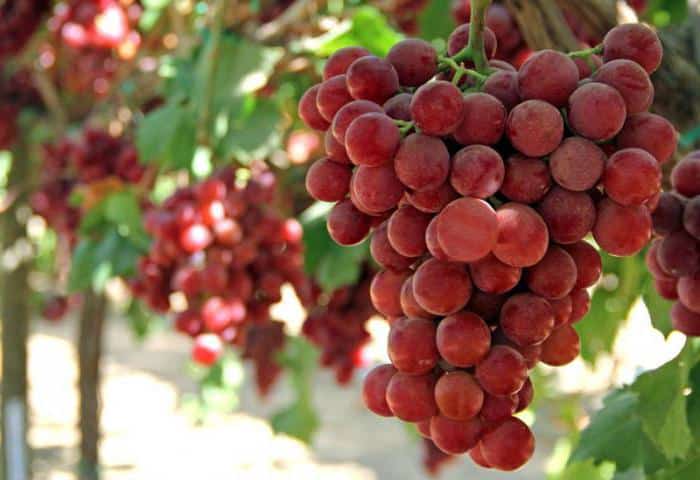
Varieties of varieties and nuances when growing
Among the early-ripening varieties of the described hybrid, Lakomka and Gurman Early are distinguished.
Gourmet
Rounded fruits of this variety have a light reddish color and nutmeg taste. Ripen bunches of grapes approximately 4 months from the beginning of the appearance of leaves. The high-yielding variety is resistant to infections and various kinds of damage. The branchy shrub tolerates cold weather well, withstanding 26-degree frosts.
Early
Unlike Gourmet, this variety of the described hybrid is a medium-sized variety with a later ripening period for berries. The pinkish berries are round and have a pleasant taste. The vineyard is practically not susceptible to diseases, and thanks to its high yields and other positive characteristics, it deservedly gained popularity.
